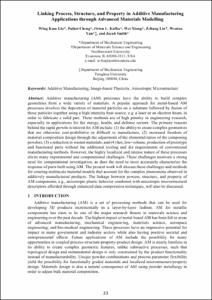Mostra el registre d'ítem simple
Linking process, structure, and property in additive manufacturing applications through advanced materials modelling
| dc.contributor.author | Liu, Wing Kam |
| dc.contributor.author | Cheng, Puikei |
| dc.contributor.author | Kafka, Orion L. |
| dc.contributor.author | Xiong, Wei |
| dc.contributor.author | Liu, Zeliang |
| dc.contributor.author | Wentao, Yan |
| dc.contributor.author | Smith, Jacob |
| dc.date.accessioned | 2015-10-05T14:39:24Z |
| dc.date.available | 2015-10-05T14:39:24Z |
| dc.date.issued | 2015 |
| dc.identifier.citation | Liu, Wing Kam [et al.]. Linking process, structure, and property in additive manufacturing applications through advanced materials modelling. A: COMPLAS XIII. "COMPLAS XIII : proceedings of the XIII International Conference on Computational Plasticity : fundamentals and applications". Barcelona: CIMNE, 2015, p. 23-39. |
| dc.identifier.isbn | 978-84-944244-6-5 |
| dc.identifier.uri | http://hdl.handle.net/2117/77337 |
| dc.description.abstract | Additive manufacturing (AM) processes have the ability to build complex geometries from a wide variety of materials. A popular approach for metal-based AM processes involves the deposition of material particles on a substrate followed by fusion of those particles together using a high intensity heat source, e.g.a laser or an electron beam, in order to fabricate a solid part. These methods are of high priority in engineering research, especially in applications for the energy, health, and defense sectors. The primary reasons behind the rapid growth in interest for AM include: (1) the ability to create complex geometries thatare otherwise cost-prohibitive or difficult to manufacture, (2) increased freedom of material composition design through the adjustment of the elemental ratios of the composing powders, (3) a reduction in wasted materials, and (4) fast, low-volume, production of prototypeand functional parts without the additional tooling and die requirements of conventional manufacturing methods. However, the highly localized and intense nature of these processes elicits many experimental and computational challenges. These challenges motivate a strong need for computational investigation, as does the need to more accurately characterize the response of parts built using AM. The present work will discuss these challenges and methods for creating multiscale material models that account forthe complex phenomena observed in additively manufacturedproducts. The linkage between process, structure, and property of AM components, e.g., anisotropic plastic behavior combined with anisotropic microstructural descriptors afforded through enhanced data compression techniques, will also be discussed. |
| dc.format.extent | 17 p. |
| dc.language.iso | eng |
| dc.publisher | CIMNE |
| dc.subject | Àrees temàtiques de la UPC::Matemàtiques i estadística::Anàlisi numèrica::Mètodes en elements finits |
| dc.subject.lcsh | Finite element method |
| dc.subject.lcsh | Plasticity -- Mathematical models |
| dc.subject.lcsh | Plasticity |
| dc.subject.other | Additive Manufacturing |
| dc.subject.other | Image-based Plasticity |
| dc.subject.other | Anisotropic Microstructure |
| dc.title | Linking process, structure, and property in additive manufacturing applications through advanced materials modelling |
| dc.type | Conference report |
| dc.subject.lemac | Elements finits, Mètode dels |
| dc.subject.lemac | Plasticitat -- Models matemàtics |
| dc.subject.lemac | Plasticitat |
| dc.rights.access | Open Access |
| local.citation.contributor | COMPLAS XIII |
| local.citation.pubplace | Barcelona |
| local.citation.publicationName | COMPLAS XIII : proceedings of the XIII International Conference on Computational Plasticity : fundamentals and applications |
| local.citation.startingPage | 23 |
| local.citation.endingPage | 39 |


